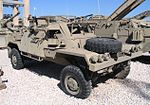|
Honduran Army
The Honduran Army is one of the three branches of the Armed Forces of Honduras, as established by the 1982 Constitution. Its recruits are all volunteers.[1] History The Honduran Army has its roots in the post-independence years, in the early 19th century. In 1831, the first Military School was founded in the San Francisco Barracks, an old nunnery.[2][3] In the next few decades many wars were fought against neighbouring countries[4]. There were also filibusters[5], hundreds of internal rebellions, and civil wars.[6] In 1909, the Corporals and Sargeants School was created, aiming to organize the army's troops over the Prussian doctrine. Nearly a decade later, in 1917, the National Military School was created to form cadets and officers for the army which was based in Toncontin, Tegucigalpa.[2] In 1937, a Machine Gun Corps was established (some 22 years after the British Machine Gun Corps had been established, and 15 years after it had been disestablished), and in 1946 the Basic Weapons School was created. In 1949, a Corporals and Sargeants School was created.[2] Three years later, the General Francisco Morazán Honduran Military Academy was established in Tegucigalpa.[7] By 1983, the army was made up by circa 13.5 thousand soldiers, distributed along three infantry brigades (each made up by two infantry battalions and one artillery battalion), six independent infantry battalions, an armoured cavalry regiment, an engineer battalion, a logistic support command, infantry schools, paratroopers and communications,[2], together with a Combined General Staff[8] with officers from all three branches of the Armed Forces.[9]  PeacekeepingThe Honduran Army has participated in various humanitarian missions headed by the UN, namely: The Army also sent a battalion to Iraq during the Iraq War, Tarea Xatruch, which made up part of the Plus Ultra Brigade.[13] Structure
ArmsThe Army's units are divided as follows:
InfantryThe infantry is provisioned with an adjustable rifle, bayonet, and survival equipment. They are divided into brigades, which then are divided into battalions, platoons, and squads. Though when the army was formed flintlocks were still the standard infantry weapon, soon Remington rifles were adopted, and then M1 Garands. World War II represented a turning point for Honduran infantry tactics, with the success of American firepower based tactics in Europe.[2]  ArtilleryThe artillery is the troop charged with the use of mortars, howitzers, rockets, missiles, etc., in offensive or defensive actions; it also is tasked with anti-air defense. The Honduran Army's modern artillery arm dates to 1971, when it was created based on the First Artillery Battalion, a unit which had been formed two years prior around a battery of 75mm guns received from the United States in 1949 and 120mm mortars.[14] Nowadays, there are three battalions of artillery in the Honduran Army.[15] CavalryAround 1750, a Horse Grenadier Corps was created in the province of Honduras by the Spanish colonial authorities, based in the city of Comayagua, though the Honduran Army's cavalry traces its roots to the Morazán Cavalry, a unit raised by President Francisco Morazán in the 19th century, famed for its mobility and performance in battle. The Army's cavalry was expanded from that unit, and maintained its organization until the end of World War I, which demonstrated the limits of traditional cavalry. Soon, armoured cars and tanks were adopted by the country's cavalry. The Football War, fought in 1969, demonstrated, however, the limitations of the armoured cavalry model adopted by the Army. In 1977, a new model was adopted where the cavalry was reformed, starting to be reorganized into Mechanized Groups, formed mostly by officers and enlisted men taken from infantry units. The first of these was equipped with 12 RBY Mk 1 Israeli light reconnaissance vehicles. Also in 1977 their designation was switched to Reconnaissance Squadrons, and then, finally, in 1981, they were merged into a single Armoured Cavalry Regiment. That year, some tens of British Scorpion, Sultan and Scimitar armoured vehicles were obtained, and construction started and ended on a base for the regiment, located at the Francisco Morazán Department.[16] In 1983, tensions with Nicaragua made Army command order the regiment's second squadron into the Valle Department; there, it fought skirmishes against the Salvadoran Army, however. In 1984, some of its tanks were handed to infantry units, in order to bolster their capabilities. That same year, 72 Saladin armoured cars were bought from West Germany, allowing the Army to reorganize its Armoured Cavalry into two regiments, with the second being deployed to the Choluteca Department, bordering Nicaragua.[17] Organization
 Human rights recordDuring the 1980s, especially during the tenure of General Gustavo Álvarez Martínez as head of the armed forces, as the Contra War was fought in Nicaragua, the Honduran Army was responsible for a number of human rights violations, especially its Battalion 3-16, trained and supported by the CIA. Said battalion was a specialized intelligence and counter-intelligence unit, formed by hand-picked officers tasked with profiling and capturing those deemed to be traitors, such as supposed communist infiltrators. Human rights groups have deemed Battalion 3-16 as a death squad, attributing more than 100 civilian deaths to it.[24] EquipmentArmored vehicles
Artillery
Anti-tank weapons
Small arms
RanksCommissioned officer ranksThe rank insignia of commissioned officers.
Other ranksThe rank insignia of non-commissioned officers and enlisted personnel.
See alsoReferences
|
|||||||||||||||||||||||||||||||||||||||||||||||||||||||||||||||||||||||||||||||||||||||||||||||||||||||||||||||||||||||||||||||||||||||||||||||||||||||||||||||||||||||||||||||||||||||||||||||||||||||||||||||||||||||||||||||||||||||||||||||||||||||||||||||||||||||||||||||||||||||||||||||||||||||||||||||||||||||||||||||||||||||||||||||||||||||||||||||||||||||||||||||||||||||||||||||||||||||



































